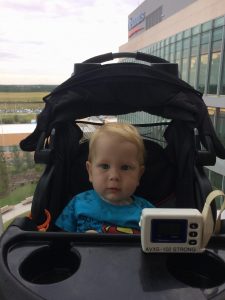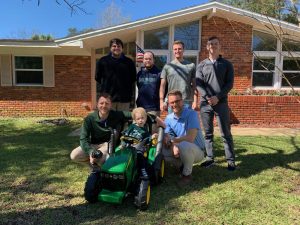[Editor’s Note: This is part of a series of articles into the discovery and development of Evrysdi, SMA’s newly approved disease-modifying therapy and its first oral, at-home one, as well as the scope of SMA issues and treatments. Here, we talk with the family of a young boy using Evrysdi in a clinical trial.]
A little boy with spinal muscular atrophy (SMA) type 2 is making big gains with Evrysdi (risdiplam) in an ongoing clinical trial, his family says.
Aleksander “Alek” Hamrick, who turned 3 in July, started taking his daily oral dose of strawberry-flavored Evrysdi on Nov. 19, 2019, as part of the JEWELFISH (NCT03032172) study.
Treatment came about one year after he was given a single, medium-strength dose of Zolgensma in a separate study, the open-label STRONG trial (NCT03381729). The gene therapy is administered in STRONG by intrathecal (IT) injection, a still investigative route that delivers it directly to the central nervous system via the spinal canal.

“It was totally night and day compared with Zolgensma,” said Alek’s father, Todd Hamrick, 48, speaking from his home in Pace, Florida, a suburb of Pensacola. “Within the third dose, he was just a different child.”
Hamrick is as grateful for that first gene therapy as he is for his son’s second liquid treatment. Alek wasn’t diagnosed with SMA until August 2018, when he was about a year old, even though his parents were aware of problems months earlier and repeatedly questioned their pediatrician.
Zolgensma, developed and marketed by Novartis and AveXis, was approved by the U.S. Food and Drug Administration (FDA) in May 2019 as a one-time intravenous infusion treatment for children up to age 2 with any type of SMA.
As a gene therapy, Zolgensma’s benefits can be slower to realize. It takes time for the virus that delivers the therapy — a healthy copy of the SMN1 gene, the main source of the SMN protein essential for muscle health — to arrive and integrate with motor neurons, specialized nerve cells that control muscle contraction.
But Evrysdi also appears to have the added benefit of no worrisome side effects, his parents said, like the rise in liver enzymes and potential immune reactions that can follow Zolgensma’s use and require steroid treatment.
“Any reaction the drug is creating systemically has been positive,” Hamrick said of Evrysdi.
SMN1 mutations that limit the SMN protein lead to a continuous loss of motor neurons — nerve cells that don’t regenerate — as the disease progresses, and widespread atrophy of skeletal and respiratory muscles in patients. Evrysdi, by Roche and Genentech (part of the Roche Group), works by modifying the genetic blueprint produced by a secondary gene, SMN2, in ways that allow it to produce more, and more stable and full length, SMN protein than this gene naturally would do.
Spinraza (nusinersen, by Biogen), the first targeted SMA therapy approved by the FDA (for all patient ages and disease types), likewise works by acting on SMN2. It is delivered by IT injection, directing the treatment to the central nervous system (brain and spinal cord), while Evrysdi, a liquid that can be swallowed alone or with food, is a systemic — or bodywide — treatment.
Since starting on Evrysdi, then known as risdiplam, in the trial at Nemours Children’s Hospital in Orlando, Alek has become much stronger and more independent, his father said. He can sit unassisted in his wheelchair without falling over, and pull himself up in his exercise pool, swim — even under water — and stay afloat.
His energy level is much higher, and his need for naps dropped from three hours a day to one, or to no nap at all. His voice is louder.
“We try to give him as much physical activity as we can because he wants it now,” Hamrick said. “Before, it was more of a chore. Now it’s just routine.”
How much of these changes are due to this newly approved daily treatment, and how much to the gene therapy, is a guess, Hamrick said. Welcome changes were becoming evident prior to Evrysdi — like raising an arm, an ability Alek had acquired and then lost over his first year of life.
“But I think risdiplam is doing something more quickly than Zolgensma,” his father said. “I am highly impressed. Alek’s development and growth is like it should be, minus the SMA.”
Today, Hamrick is “totally optimistic” about his son’s future.
He marvels at how much progress has been made in recent years — from Spinraza to Zolgensma to Evrysdi — in treating this leading genetic killer of children and counts his family as very fortunate.
Had his 9-year-old daughter Natasza been affected by SMA, her prospects “would not be good,” he said. “I’m very, very lucky.”
A delayed diagnosis
Hamrick and his wife Iwona are parents to two other children, Natasza and Kailyn, 20, and realized something was not right with Alek when he was about 6 months old. “He was not meeting the milestones. He was getting weaker,” his father said.
They voiced their concerns to their pediatrician, who diagnosed Alek first with hypotonia or “lazy baby syndrome,” and later with cerebral palsy.
“Even we knew it wasn’t cerebral palsy,” Hamrick said.
Alek began occupational and physical therapy around that time, but his decline continued. He could no longer hold up his head or raise either arm, and he never turned over in his crib.

Necessities like chewing, swallowing, and holding down food were becoming increasingly difficult.
Frightened, his parents demanded a referral to a neurologist, and Iwona, a registered nurse, had blood drawn for testing at her hospital. In early August 2018, their 12-month-old son was diagnosed with spinal muscular atrophy type 1, later changed to type 2.
“There was some damage that occurred because of that missed diagnosis,” Hamrick said, adding the delay caused the boy to lose “a lot of neurons.”
Doctors told Iwona and Todd to take their son “home and love him. There’s nothing they could do,” Hamrick said. “They were so misinformed.”
Searching online, the couple learned about Spinraza, approved almost two years earlier, and arranged to begin treatment. However, an appointment for a first injection was postponed when a racehorse belonging to the treating doctor took ill.
That same day, the family was notified by another neurologist they had contacted, Richard Finkel who was then at Nemours, that Alek might qualify for STRONG and Zolgensma. Nemours, in Orlando, is about an eight-hour car trip from the Hamrick’s home. His parents readily agreed.
Spinraza “wouldn’t have been bad either,” Hamrick said in a telephone interview, adding that his family is close friends with the family of Asher Camp, who was among the first type 1 babies treated with this Biogen therapy in its initial clinical trial. Asher, now 7 and still using Spinraza, is thriving.
But you’ve “a decision you have to make and you make it,” Hamrick said. “We flew to Orlando and never looked back.”
Aleksander, then 15 months old, was enrolled in STRONG and given a single spinal injection of Zolgensma, at a middle dose, on Oct. 11, 2018. For the next year, he and his family traveled to Nemours monthly for three days of intensive testing under Finkel’s supervision.
Zolgensma was working, but the changes came slowly, Hamrick said. “There was really nothing explosively noticeable.”
About one month post-therapy, Alek’s bowel movements turned more normal, his gastroesophageal reflux problems eased, and his breathing improved, his father said. At about five months, he began to show small progress in his occupational, physical, and aqua therapies.
When the toddler’s part in STRONG ended, Finkel invited the seven families in his dosing group to move to another study. The Hamricks, with other families, chose JEWELFISH. This trial was unique among risdiplam studies in accepting previously treated patients.
While delighted with his son’s progress to date, Hamrick acknowledges that he cannot say for sure whether the steady gains now being seen are due to treatment with Evrysdi or with Zolgensma, or some combination of the two.
‘Be your child’s voice’
For JEWELFISH, the family travels to Nemours every 75 days for vision exams, physical assessments, blood work, and other tests. The hospital ships Evrysdi, refrigerated, to their home about every seven weeks free of charge.

While Alek’s disease was initially difficult for the family — “we’d never even heard of [SMA], shamefully” — it has made them closer.
Hamrick, a U.S. Army veteran who retired at 32 for medical reasons, devotes much of his time to caring for his son while Iwona works. Alek’s two sisters help with care when their dad has other chores to take on.
Alek compensates intellectually for any physical limits, Hamrick said, and is ahead of his two siblings at similar ages.
“Nothing gets past him,” he said, noting that Alek was the first to learn his mother’s native Polish, and has an excellent memory and a lively imagination.
The family recently moved to a 15-acre horse farm in Pace from nearby Gulf Breeze, because the farm’s better suited to the boy’s wheelchair and therapy needs.
Given his family’s journey through misdiagnoses and delays, Hamrick advises other parents to never blindly accept what health professionals tell them.
“It pays to do your own research,” he said. “You have to be your child’s voice.”
As for Evrysdi, he recommends that anyone touched by SMA be on the “lookout” for it.
“They just knew what they were doing,” Hamrick said. “It’s been great. There’s really been no problems, none.”
"type" - Google News
August 12, 2020 at 07:00PM
https://ift.tt/30PcDof
Evrysdi Has Parents 'Totally Optimistic' for Toddler With SMA Type 2 - SMA News Today
"type" - Google News
https://ift.tt/2WhN8Zg
https://ift.tt/2YrjQdq
Bagikan Berita Ini














0 Response to "Evrysdi Has Parents 'Totally Optimistic' for Toddler With SMA Type 2 - SMA News Today"
Post a Comment